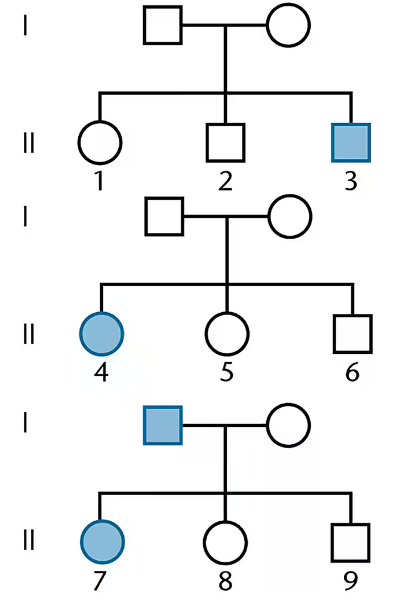Draw all possible conclusions concerning the mode of inheritance of the trait portrayed in the following limited pedigree.
Table of contents
- 1. Introduction to Genetics51m
- 2. Mendel's Laws of Inheritance3h 37m
- 3. Extensions to Mendelian Inheritance2h 41m
- 4. Genetic Mapping and Linkage2h 28m
- 5. Genetics of Bacteria and Viruses1h 21m
- 6. Chromosomal Variation1h 48m
- 7. DNA and Chromosome Structure56m
- 8. DNA Replication1h 10m
- 9. Mitosis and Meiosis1h 34m
- 10. Transcription1h 0m
- 11. Translation58m
- 12. Gene Regulation in Prokaryotes1h 19m
- 13. Gene Regulation in Eukaryotes44m
- 14. Genetic Control of Development44m
- 15. Genomes and Genomics1h 50m
- 16. Transposable Elements47m
- 17. Mutation, Repair, and Recombination1h 6m
- 18. Molecular Genetic Tools19m
- 19. Cancer Genetics29m
- 20. Quantitative Genetics1h 26m
- 21. Population Genetics50m
- 22. Evolutionary Genetics29m
2. Mendel's Laws of Inheritance
Pedigrees
Problem 30c
Textbook Question
Consider the three pedigrees below, all involving a single human trait.

Given your conclusions in part (a), indicate the genotype of the following individuals: II-1, II-6, II-9 If more than one possibility applies, list all possibilities. Use the symbols A and a for the genotypes.
 Verified step by step guidance
Verified step by step guidance1
Step 1: Analyze the pedigree chart to determine the inheritance pattern of the trait. Look for clues such as whether the trait skips generations (indicative of recessive inheritance) or appears in every generation (indicative of dominant inheritance).
Step 2: Identify the individuals in question (II-1, II-6, II-9) and their relationships within the pedigree. Note whether they are affected or unaffected by the trait.
Step 3: Assign genotypes based on the inheritance pattern. For a recessive trait, affected individuals must be homozygous recessive (aa), while unaffected individuals can be either homozygous dominant (AA) or heterozygous (Aa). For a dominant trait, affected individuals can be either heterozygous (Aa) or homozygous dominant (AA), while unaffected individuals must be homozygous recessive (aa).
Step 4: Use the parental genotypes and offspring phenotypes to narrow down the possible genotypes for II-1, II-6, and II-9. For example, if an unaffected parent has an affected child, the parent must be heterozygous (Aa).
Step 5: List all possible genotypes for II-1, II-6, and II-9 based on the analysis. If there is ambiguity due to incomplete information, include all plausible options.
 Verified video answer for a similar problem:
Verified video answer for a similar problem:This video solution was recommended by our tutors as helpful for the problem above
Video duration:
4mPlay a video:
Was this helpful?
Key Concepts
Here are the essential concepts you must grasp in order to answer the question correctly.
Pedigree Analysis
Pedigree analysis is a genetic tool used to trace the inheritance patterns of traits through generations in a family. It visually represents relationships and can indicate whether a trait is dominant or recessive based on the presence or absence of the trait in family members. Understanding how to read and interpret pedigrees is crucial for determining genotypes of individuals based on their familial connections.
Recommended video:
Guided course

Pedigree Flowchart
Genotype and Phenotype
The genotype refers to the genetic makeup of an individual, represented by alleles (e.g., AA, Aa, aa), while the phenotype is the observable expression of that genotype, influenced by both genetics and the environment. In the context of the question, identifying the genotype of individuals II-1, II-6, and II-9 requires understanding how their phenotypes relate to their parents' genotypes and the inheritance pattern of the trait in question.
Recommended video:
Guided course

Gamete Genotypes
Dominant and Recessive Alleles
In genetics, alleles can be classified as dominant or recessive. A dominant allele (A) will express its trait even if only one copy is present, while a recessive allele (a) requires two copies to express the trait. This distinction is essential for predicting the possible genotypes of individuals in a pedigree, as it helps determine which combinations of alleles can result in the observed traits in the offspring.
Recommended video:
Guided course

Variations on Dominance
Related Videos
Related Practice
Textbook Question
913
views


